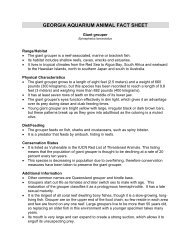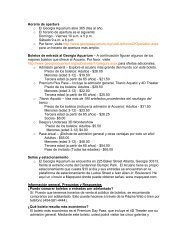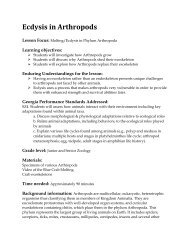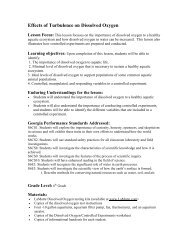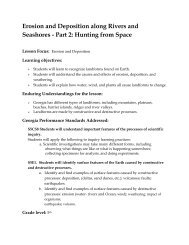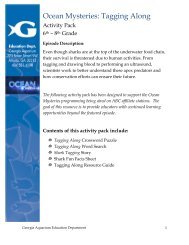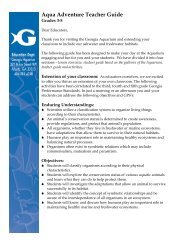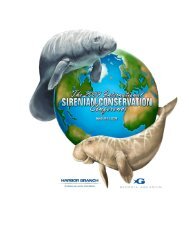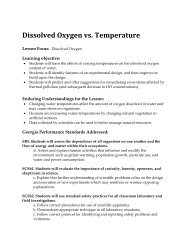Animal Behavior - Georgia Aquarium
Animal Behavior - Georgia Aquarium
Animal Behavior - Georgia Aquarium
Create successful ePaper yourself
Turn your PDF publications into a flip-book with our unique Google optimized e-Paper software.
<strong>Animal</strong> <strong>Behavior</strong><br />
Teacher Guide<br />
Grades 9-12<br />
Program Description: Before animals can live in an aquarium,<br />
biologists must understand what they need and how they behave.<br />
Students will discover how the <strong>Aquarium</strong> staff maintains the health of our<br />
animals as well as the training and enrichment techniques used in the<br />
process.<br />
Enduring Understandings:<br />
Observation is the best way to study and understand animal behavior.<br />
Understanding animal behavior helps us to maintain animals in<br />
aquariums and to protect their populations in the wild.<br />
Objectives:<br />
Students will observe and interpret animal behaviors in the <strong>Aquarium</strong>.<br />
Students will recognize the importance of animal training and<br />
enrichment.<br />
<strong>Georgia</strong> Performance Standards<br />
SCSh1. Students will evaluate the importance of curiosity, honesty,<br />
openness and skepticism in science.<br />
a. Exhibit the above traits in their own scientific activities.<br />
b. Recognize that different explanations often can be given for the<br />
same evidence.<br />
SCSh6. Students will communicate scientific investigations and<br />
information clearly.<br />
d. Participate in group discussions of scientific investigation and<br />
current scientific issues.<br />
SZ4 Students will assess how animals interact with their environment<br />
including key adaptations found within animal taxa.<br />
b. Relate animal adaptations, including behaviors, to the ecological<br />
roles played by animals<br />
The <strong>Georgia</strong> <strong>Aquarium</strong> ~ Education Department 1
Before coming to the aquarium, the students should understand that:<br />
The <strong>Aquarium</strong> is not only an educational and entertainment facility but a research<br />
facility as well.<br />
Positive reinforcement is a training method that rewards animals for good<br />
behaviors.<br />
Activities:<br />
1. Ethogramania (pre-visit) - Students will practice their field research skills by<br />
observing an animal and creating an ethogram of the animal’s common behaviors.<br />
2. Beluga Observation Lab (to be done at the <strong>Aquarium</strong>, post-visit) -Students will<br />
use their new research skills to study the behavior of our beluga whales.<br />
The <strong>Georgia</strong> <strong>Aquarium</strong> ~ Education Department 2
Ethogramania (pre-activity)<br />
Grades: 9-12<br />
Objective: Students will see firsthand what it means to be an animal researcher by<br />
observing an animal, creating an ethogram (a catalog of behaviors), collecting data on<br />
the animal’s behavior and drawing conclusions from that data.<br />
Duration: 2 class periods and homework time<br />
Materials:<br />
Copies of the “<strong>Animal</strong> Data Collection” worksheet (1 for each student)<br />
Background:<br />
An understanding of animal behavior is important to scientists to protect and manage<br />
animal populations in the wild, know where and how animals spend their time, what<br />
they eat, when they mate and what the structure is of their social groups. This can also<br />
help us better understand ecosystems and to predict human impacts.<br />
If we are going to maintain animals in zoos or aquariums, we need to know as much as<br />
possible about their specific needs and behaviors. This helps us to determine what their<br />
nutritional requirements are, how much space they need, which animals can and cannot<br />
be housed together. Understanding behavior can also help biologists monitor their<br />
health and reactions to changes in their environment.<br />
Observation is the best method researchers have for learning about the behavior of a<br />
species or an individual animal. Through repeated observations, researchers can<br />
develop an understanding of an animal’s baseline behavior (“normal” behavior for that<br />
animal). Once this baseline is developed, observations at different times or in different<br />
situations can show researchers which factors cause variations in the animal’s behavior.<br />
Researchers often collaborate when conducting animal behavior research. To ensure the<br />
researchers see and interpret behaviors the same way, researchers will create an<br />
ethogram, a visual or written catalog of the common behaviors for a particular species.<br />
These descriptions may be written and/or pictorial.<br />
The <strong>Georgia</strong> <strong>Aquarium</strong> ~ Education Department 3
Procedure:<br />
First Day (in class):<br />
1. Go over background information with the students. Discuss the importance of<br />
animal behavior research and the methods used in research.<br />
2. Explain ethograms and show the students an example of one. Ask the students<br />
how they think researchers develop ethograms.<br />
3. Explain to the students that they will be developing an ethogram of their own<br />
and using it to collect data on animal behavior.<br />
4. Pass out <strong>Animal</strong> Data Collection worksheets for students to take home.<br />
Homework (may be done over several days):<br />
1. Have each student choose an animal (a pet, a friend’s pet, an animal easily<br />
viewed in a backyard, park, or in your house), and observe the animal for 15<br />
minutes.<br />
2. During observation, students should take notes on the animal’s behaviors,<br />
beginning to separate and identify distinct behaviors.<br />
3. Using the data collected from these preliminary observations, students will<br />
create an ethogram by choosing 5 specific behaviors and making a list of these<br />
behaviors with a description of each one. Alternatively, students may use<br />
photographs or sketches to represent the behaviors.<br />
4. Once the students have developed their ethograms, they will fill in the names of<br />
the five behaviors in the spaces on their <strong>Animal</strong> Data Collection sheet.<br />
5. Students will use the worksheet to do 3 separate observations of their animal.<br />
Teacher may decide if these observations should be done at different times on<br />
the same day or at the same time for 3 consecutive days.<br />
6. Before each observation session, the student should record the date, time, and<br />
any environmental factors (weather if they are outside, noise, presence of other<br />
animals or people, etc.).<br />
7. During each observation session, the student will watch their animal for 5<br />
minutes, recording its behavior every ten seconds (they can count these out<br />
rather than using a timer). For example, once they start their five minute session,<br />
they will count to ten. On ten, whatever behavior the animal is performing is<br />
what they will mark down a tally for on their worksheet. They then start over<br />
counting to ten and repeat until their 5 minutes are up.<br />
8. Students may use the “additional observations” section on their worksheet to<br />
record any “other” or unusual behaviors or to make any notes.<br />
9. After finishing all three observation sessions, each student should write a few<br />
paragraphs explaining what conclusions they can draw from their observations,<br />
any difficulties they had, and anything they think merits further study.<br />
Last Day (in class):<br />
1. As a class, discuss the students’ data collection experiences. What difficulties did<br />
they have? Were there factors that affected the collection process? How do they<br />
think they could improve the study methods?<br />
2. Either split the students into groups to have them discuss their findings with<br />
each other, or have each student give a brief presentation of their conclusions.<br />
The <strong>Georgia</strong> <strong>Aquarium</strong> ~ Education Department 4
<strong>Animal</strong> Data Collection Sheet<br />
Directions: Select an animal. This can be a pet, common animal found in your backyard,<br />
animal in a park, etc. On three separate occasions, time yourself for 5 minutes and tally the<br />
observed behaviors on the charts below. Tallies should be recorded every 10 seconds<br />
(student can count this out rather than using timer).<br />
<strong>Animal</strong>: ________________________<br />
Date: _______ Time: ______<br />
Environmental Factors (i.e. noise, weather, etc.):<br />
___________________________________________<br />
<strong>Behavior</strong> Tallies of Occurrences Total<br />
Other<br />
Additional Observations:<br />
______________________________________________________________________________________________<br />
______________________________________________________________________________________________<br />
______________________________________________________________________________________________<br />
Date: _______ Time: ______<br />
Environmental Factors (i.e. noise, weather, etc.):<br />
__________________________________________________<br />
<strong>Behavior</strong> Tallies of Occurrences Total<br />
Other<br />
Additional Observations:<br />
_____________________________________________________________________________________________<br />
_____________________________________________________________________________________________<br />
_____________________________________________________________________________________________<br />
The <strong>Georgia</strong> <strong>Aquarium</strong> ~ Education Department 5
Date: _______ Time: _______<br />
Environmental Factors (i.e. noise, weather, etc.):<br />
__________________________________________________<br />
<strong>Behavior</strong> Tallies of Occurrences Total<br />
Other<br />
Additional Observations:<br />
_____________________________________________________________________________________________<br />
_____________________________________________________________________________________________<br />
_____________________________________________________________________________________________<br />
The <strong>Georgia</strong> <strong>Aquarium</strong> ~ Education Department 6
Beluga Observation Lab (post activity)<br />
*** This optional activity should be done at the <strong>Aquarium</strong> after your program (or if<br />
necessary due to scheduling you can do it before your program)<br />
Grades: 9-12<br />
Objective: Students will use their new skills as animal behaviorists to observe and<br />
collect data on our beluga whales.<br />
Materials:<br />
Copies of the “Beluga <strong>Behavior</strong> Data Collection” sheet (one per student)<br />
Copies of the “Beluga <strong>Behavior</strong>s” ethogram (one per student)<br />
Copies of “Beluga Identification” sheet (one per student)<br />
Duration:<br />
15 min at the <strong>Aquarium</strong> for observations<br />
15-20 min (or as much time as desired for analysis and conclusions at school)<br />
Background:<br />
Through the “Ethogramania” pre-visit activity and/or their animal behavior program,<br />
students should have learned the basics of how and why we observe animal behavior,<br />
what an ethogram is and how and why it is used. An ethogram is a visual or written<br />
catalog of the common behaviors for a particular species. Using an ethogram helps<br />
maintain consistency when observations are being performed by multiple researchers.<br />
Observing animal behavior helps us to learn more about species and individuals, to<br />
keep them healthy in an aquarium environment, and to conserve them in the wild.<br />
Observation is a key part of the job of an aquarium biologist. Our biologists observe<br />
our animals, informally, on a daily basis in order to better meet their needs.<br />
Procedure:<br />
1. Take your group to the beluga viewing window (if it is crowded, it may be easier for<br />
them to observe from the second level, at the end of the Coldwater Quest gallery.<br />
2. Pass out “Beluga <strong>Behavior</strong> Data Collection” sheets, beluga ethograms, pens, and<br />
notebooks (or other hard surface for writing on).<br />
3. Give the students a few minutes to study the ethogram and to observe the belugas’<br />
behaviors.<br />
4. Have each student choose a beluga to study. Have students identify their beluga by<br />
using the “Beluga Identification” sheet. The students should circle the name of the<br />
beluga they will study at the top of their page.<br />
5. When everyone has chosen a beluga to study, have them read over the procedures<br />
above “Beluga <strong>Behavior</strong> Data Collection” sheets.<br />
The <strong>Georgia</strong> <strong>Aquarium</strong> ~ Education Department 7
6. Once everyone is clear on the procedure, begin timing the trials. Start timing and<br />
tell the students to begin trial 1. After 30 seconds, tell them to move to trial 2.<br />
Continue for 30 trials (15 minutes).<br />
7. At the end of the trials, have the students total the number of trials in which they<br />
observed each behavior, as well as make notes about any “other” or unusual<br />
behaviors they observed.<br />
Wrap-up:<br />
At the <strong>Aquarium</strong> or back in the classroom, have the students compare results. Did<br />
Beethoven and Maris have similar behaviors? Did the older and younger whales have<br />
behaviors that were similar? Were there some behaviors that were observed more in<br />
one beluga or the other? What did they observe that was unusual or that they couldn’t<br />
explain? Have them brainstorm reasons behind these “other” behaviors.<br />
As an extension, you can have the students graph behaviors in multiple ways.<br />
The <strong>Georgia</strong> <strong>Aquarium</strong> ~ Education Department 8
Beluga <strong>Behavior</strong> Data Collection<br />
Observed Beluga (circle one): BEETHOVEN or MARIS<br />
GRAYSON or QINU<br />
Procedure: Adult will time thirty, 30 second trials (intervals). Students will indicate that they<br />
observed a specific behavior by checking the box. Only one check mark is needed per observed<br />
behavior, per trial, regardless of the number of times a behavior is observed during that trial<br />
(e.g. if the beluga breathes four times during trial one, only one checkmark is needed)<br />
To signal the end of one trial, the adult will instruct students to begin the next trial. At the<br />
beginning of each, remind the students which trial number they should be starting (e.g. “being<br />
trial 2”). At the conclusion of the ten trials, students will total the number of trials in which<br />
each behavior was observed.<br />
The <strong>Georgia</strong> <strong>Aquarium</strong> ~ Education Department 9
Beluga <strong>Behavior</strong> Data Collection<br />
Time (30 Second Intervals)<br />
<strong>Behavior</strong> 1 2 3 4 5 6 7 8 9 10 11 12 13 14 15 TOTALS<br />
Diving<br />
Interaction<br />
Swimming<br />
Rock Rub<br />
Breathing<br />
Other<br />
Not<br />
Visible<br />
<strong>Behavior</strong> 16 17 18 19 20 21 22 23 24 25 26 27 28 29 30 TOTALS<br />
Diving<br />
Interaction<br />
Swimming<br />
Rock Rub<br />
Breathing<br />
Other<br />
Not<br />
Visible<br />
The <strong>Georgia</strong> <strong>Aquarium</strong> ~ Education Department 10
NOTE: Any behavior not pictured above may be tallied as<br />
“Other”<br />
The <strong>Georgia</strong> <strong>Aquarium</strong> ~ Education Department 11
Beluga Identification<br />
The <strong>Georgia</strong> <strong>Aquarium</strong> ~ Education Department 12



